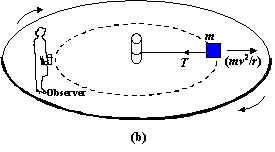Physics Assignment Help With Centripetal Force

What is Centripetal Force?
The force that is necessary to keep an object moving in a curved path and that is directed inward toward the center of rotation called centripetal force. Centripetal force that is constantly acting on a object that is moving in a circle at a uniform speed. This force is always acting toward the center of the circular path. When such an object continues to move in its circular path without being pulled towards its center, the centripetal force must be balanced by an equal and opposite centrifugal force.
The centripetal force, the action, is balanced by a reaction force, called centrifugal force. The two forces are equal in magnitude and opposite in direction. The centrifugal force does not act on the body in motion; the only force acting on the body in motion is the centripetal force.
What is Centrifugal Force?
Centrifugal force is the force which describes the outward pressure that is exhibited around an object rotating around a central point. Centrifugal force arises due to the property of mass known as inertia - the reluctance of a body to change either its speed or direction. A body that is at rest will stay at rest until some external force makes it move, and then will continue to move at the same speed and in the same direction unless and until some force changes the way it is moving.
Newton's laws of motion:
The three laws of motion were first compiled by Sir Isaac Newton in 1687.
- Newton's First Law of Motion: Every object in a state of uniform motion tends to remain in that state of motion unless an external force is applied to it. (Referred sometimes as The Law of Inertia)
- Newton's Second Law of Motion: The relationship between an object's mass m, its acceleration a, and the applied force F is F = ma.
- Newton's Third Law of Motion: For every action there is an equal and opposite reaction.
You can also see the action of this force with following example as follow:
A body moving with constant speed in a circular path is continuously accelerated towards the centre of rotation. The magnitude of acceleration is given by

Where:- ![]() is the constant speed
is the constant speed ![]() and
and ![]() is the radius of the circular path.
is the radius of the circular path.
According to Newton's Second Law, a body moving in a circular path with constant speed must be acted upon by an unbalanced force which is always directed towards the centre. This necessary unbalanced force is called the centripetal force.
The magnitude of the centripetal force on an object of mass m moving at a speed v along a path with radius of curvature r is given by:
![]()
Some Important Facts:
- A body moving with constant speed in a circle is not in equilibrium.
- It should be remembered that in the absence of the centripetal force the body will move in a straight line with constant speed.
- It is not a new kind of force which acts on bodies. In fact, any force which is directed towards the centre may provide the necessary centripetal force.
For Example
- When a stone tied with a string is rotated in a circular path, the tension in the string provides the centripetal force.
- When a car negotiates a curve the force of friction between the tyres and the road provide the necessary centripetal force.
- The gravitational force of attraction between the sun and a planet provides the centripetal force.
- The electric force of attraction between the nucleus and the revolving electron provides the centripetal force in an atom.
Centrifugal force is a pseudo force which is experienced by a non-inertial observer moving in a circular path with constant speed. Its magnitude is equal to that of the centripetal force but its direction is exactly opposite to that.


Fig: A block is tied to the centre post of a rotating platform by a string.
- An inertial observer sees the block moving in a circle with centripetal acceleration provided by the unbalanced force T.
- According to a non inertial observer on the platform, the block is not accelerating. Newton's second law can be used only if a pseudo force mv2/r acting outward is introduced to balance the tension.
We are ready with Physics Homework/Assignments Help. Assignmenthelp.net is a leading online tutoring company which provides its educational services to the world-wide students. Our quality services include Physics Assignment Help, physics online tutoring, online physics help, and physics experiment report. Students can clear about their problems/doubt regarding centripetal force and centrifugal force in physics.
Customer Support Services (live 24/7):
We believe in strong customer service that will support all grade students in reaching their educational goals. We believe in focusing on results, quality and continuous improvement of physics online tutoring to be more efficient and effective. Our expert physics tutors are ready to help you around the clock. We have professional and well-trained physics tutors, who are competent, accountable and empowered to provide industry best solutions in physics to our end users.
To submit Physics Courses Click here


